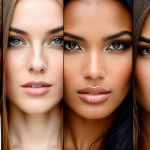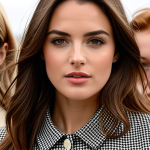Key Influences on UK Women’s Fashion Choices
Understanding fashion trends UK involves examining numerous factors shaping how UK women style themselves. Social and cultural shifts play a critical role; generational differences often dictate whether classic or avant-garde looks dominate. Younger women may gravitate toward bold, experimental styles, while older generations prioritize timeless elegance, reflecting diverse lifestyle needs.
The influence of media remains pivotal. Traditional outlets like fashion magazines coexist with digital platforms, amplifying visibility for certain trends. This media mosaic shapes UK women style by constantly exposing audiences to varied aesthetics, enabling quick trend adoption or resistance.
Also read : How Do UK Women’s Fashion Trends Vary Across Different Regions?
Celebrity culture significantly impacts fashion influences. When renowned UK personalities showcase new outfits, their followers often emulate these choices, accelerating trend diffusion. Fashion icons, from musicians to actors, serve as style benchmarks, blending personal flair with broader cultural narratives.
Together, these elements create a dynamic tapestry where fashion influences fluctuate yet resonate deeply within the UK’s shopping aisles and wardrobes. Recognizing these layers helps explain why some trends gain widespread appeal while others remain niche.
Also read : Why Are British Women’s Fashion Trends Evolving Rapidly?
Sources of Fashion Inspiration for UK Women
In the realm of fashion inspiration UK offers a vibrant mix shaped strongly by digital and traditional media. Social media platforms like Instagram and TikTok are pivotal, providing instant access to evolving styles and serving as daily lookbooks. UK women style themselves by following influencer posts and viral content, often recreating trends featured on these platforms.
Celebrity style UK heavily impacts fashion choices. When popular figures debut new looks, their images rapidly circulate, seeding ideas that fans readily embrace. This direct line between celebrity wardrobes and personal fashion underlines how critical celebrity style UK remains as a trend catalyst.
Style magazines continue to hold relevance, albeit in a digitalized form. They curate seasonal collections and interviews that frame emerging trends, appealing to those seeking deeper context beyond quick social media snapshots. Street style and peer influence also contribute authentically, adding grassroots momentum to trend adoption.
Overall, UK women’s fashion inspiration is a layered interplay of rapid social media updates, celebrity influence, and curated editorial content. Together, these sources create a dynamic ecosystem where fashion inspiration UK is both accessible and richly diverse.
Demographic Differences in Fashion Choices
Demographic factors significantly shape UK women style, reflecting variations across age, region, and socioeconomic status. Age groups influence fashion preferences distinctly; younger women often prioritize experimental, trend-forward outfits, embracing vibrant hues and eclectic designs. Conversely, older demographics usually favor classic, versatile pieces, emphasizing comfort and elegance that suit established lifestyles.
Regional disparities also play a vital role. Urban areas like London exhibit diverse and fast-evolving fashion trends UK, propelled by multicultural influences and vibrant street culture. In contrast, rural or smaller communities might lean toward practical, understated styles. These regional preferences reveal how locality intertwines with identity and fashion expression.
Socioeconomic status impacts fashion access and choices profoundly. Higher income brackets can readily afford premium brands and emerging designers, aligning with luxury trends. Conversely, budget-conscious consumers focus on affordability and durability, often mixing high-street finds with classic staples.
Understanding these fashion demographics UK is crucial for grasping the complexity behind trend adoption and style diversity. Recognizing that fashion is not one-size-fits-all helps explain why UK women’s wardrobes contain a mosaic of influences shaped by life stage, geography, and financial means.
Seasonal and Emerging Fashion Trends
Seasonal fashion trends UK evolve continually, responding to climate shifts and cultural cycles. Spring and summer often embrace lighter fabrics and brighter palettes, while autumn and winter highlight layering, textures, and darker tones. This cyclical rhythm influences how UK women style themselves, ensuring wardrobes remain versatile and weather-appropriate.
Upcoming trends reflect both innovation and sustainability, as UK fashion experts increasingly promote eco-friendly materials and ethical production. Surveys indicate rising interest in minimalist shapes, gender-neutral pieces, and vintage revivals. These emerging trends reveal a blend of practicality and statement-making styles, capturing contemporary values without sacrificing individuality.
Notable designers contribute to shaping UK women style by introducing fresh silhouettes and bold color combinations each season. Their influence drives demand for unique garments that merge tradition with modernity. Attention to detail, such as artisanal craftsmanship and technological fabric enhancements, also defines these new trends.
By monitoring seasonal fashion trends UK and expert insights, consumers can anticipate shifts and adapt their style choices effectively. This awareness supports a more curated wardrobe aligned with current aesthetics and future-forward concepts.
Key Influences on UK Women’s Fashion Choices
Fashion trends UK are shaped by intertwined social, cultural, and generational factors. Younger generations often lead with experimental, bold styles, rapidly adopting new looks, while older demographics prefer enduring, classic designs suited to their lifestyles. These generational divides influence the pace and nature of trend adoption, reflecting deeper cultural identities.
Media platforms play a powerful role in shaping UK women style preferences. The coexistence of traditional outlets like style magazines and dynamic digital channels ensures diverse fashion influences reach broad audiences. Instagram, TikTok, and other social media platforms provide immediate, visual access to trends, allowing quick dissemination and feedback, which accelerates preference shifts.
Celebrity culture additionally impacts these choices uniquely. Fashion icons, from emerging stars to established personalities, serve as trendsetters. When celebrities debut styles, their fans often emulate them, bridging celebrity style with everyday wardrobes. This phenomenon highlights how fashion influences extend beyond aesthetics to embody aspirational and relational appeal.
Together, these factors construct a complex network that continually redefines fashion trends UK and shapes how UK women express identity through clothing. Understanding this nexus reveals why fashion evolves fluidly in response to cultural currents and media-driven momentum.





